The Canada Atlantic Railway Elgin Street
Station
with David Jeanes The Queensway at the foot of Elgin Street today
occupies the site of Ottawa's fourth main railway station. The Canada Atlantic
Railway reached Elgin Street in September 1882. The St. Lawrence and
Ottawa (originally Bytown and Prescott) had been at Sussex and McTaggart since
1854-5 and the Canada Central had built a station on Lebreton Flats in 1870.
The first Union station, on Broad Street at Ottawa Street on Lebreton Flats
was opened in May 1881 when the Quebec, Montreal, Ottawa and Occidental Railway
extended from Hull over the Prince of Wales bridge to join the Canada Central.
During the 1880s all of these railways were taken over by the Canadian Pacific,
(CCR in June 1881, QMO&O in June 1882 and the St. L&O in September
1884).
The Canada Atlantic was conceived as the Montreal & City of Ottawa Junction Railway, to connect to the Grand Trunk at Coteau. On 7 April 1874, City Council passed a bylaw offering a $100,000 bonus, requiring the promoters to acquire 2 acres for a station in the vicinity of Elgin Street, and to spend $25,000 of the bonus on workshops within the city limits. By 1878, however, the project was floundering and the city threatened to withdraw the bonus. In the end it was never paid. Ottawa lumber barons J.R. Booth and W.G. Perley and Governor J. Gregory Smith of Vermont took over the company in 1881, and under the new Canada Atlantic name, the tracks were pushed from Coteau towards Ottawa. The consulting engineer for the railway was the famed civil engineer and member of parliament, Walter Shanly, who had already built the Bytown and Prescott Railway, the Hoosac Tunnel and the Western Division of the Grand Trunk. At this date he was also the general manager of the St. Lawrence & Ottawa. At Ottawa, Shanly originally drew a plan on 16 February 1882, (RG46 volume 1476 file 16558-1), to bring the line well south of Lees Avenue through Ottawa East and then to across Main Street and the Canal at an angle, continuing north up Elgin Street as far as Gilmour or MacLaren. A wye south of Catherine Street would lead westward to a track for turning trains, and continue to the Chaudière, all the way to the Union Bridge to Hull. The final plan, however, kept the line north of Lees Avenue and crossed the Canal on the present east-west line of the Queensway on a swing bridge (or "drawbridge"). The passenger station was built along Catherine Street and the freight yard and shed along Isabella Street. The yard lead continued across Bank Street and along what was then a continuation of Isabella Street. 
The Buildings
A newspaper account of October 1882 described the original buildings. The passenger station was a large frame one-storey pitched roof structure, containing waiting room, ticket office, and telegraph office. It had a bay window for the operator, which was then considered an innovation. It predated the CPR Van Horne stations which also had bay windows. There was a 300-foot long covered platform with a flat canopy roof. Unfortunately no clear photos of the station in its original form have been found. Just east of Elgin Street a car shed was built to hold two complete train sets. It was 200 feet long and 39 feet wide and also of frame construction. At that date the railway was still using 48-foot cars and the normal consists for Montreal trains were a baggage car, second and first class coaches, and a parlour or chair car. A through sleeper or parlour car from the Intercolonial Railway might bring up the rear after 1889, when the ICR had obtained running rights to Montreal. North of the shed on Archibald Street (today Argyle at Cartier), was the 5-stall roundhouse. The stalls were 72 feet long. The early CAR engines were wood-burners, so there was no coaling facility, just a water tower. Within a few feet of the turntable a two-storey house, which faced on to Catherine Street was retained as the "Mechanical Office" of the railway. The roundhouse and turntable appear with locomotive #4 in an early shot The smokestack vents have a curious double cone, one of which is in the open position. The machinery in the shop was powered from a motor annex behind the rightmost stall, and its smokestack is visible in the rear. The second picture shows the roundhouse from across the canal after it had been extended from five to eight stalls. A trio of builders, possibly local contractors, were credited with the buildings. Mr. Black for the car shed, Mr. White for the roundhouse, and MacLaren and Parkham for the station. The latter were also responsible for all the other stations between Ottawa and Coteau and possibly as far as the Vermont border, which were mostly of the standard design which is preserved in the Barrington Station at the Canadian Railway Museum at Delson. The Elgin Street station, though larger than Barrington (72 x 24 feet instead of 30 x 18) used the same Victorian roof decoration, including diagonal cross-bracing, a boss, and carved rooftop finials, and brick chimneys. The bay window was probably similar, and the window style and framing was much the same. However instead of Barrington's three-part gothic-style end window, Elgin Street had a circular window in the gable containing a large clock, visible from the locomotive and to passengers approaching the station. Some major changes were carried out in December 1894 when the CAR offices were moved out to make room for a ladies waiting room and a restaurant which was run by a Mr. Burgess. The federal government leased land west of Elgin Street Station to build a two-track shed for government private cars. This shed was effectively abandoned long before the lease expired, and the Canada Atlantic eventually asked to take it back. This shed lasted into the Grand Trunk era. Passenger Services
The Canada Atlantic set out to provide a first-class passenger service from Elgin Street. By the August 1883 timetable, an express run was covering the 78.4 miles to Coteau at an average of 50.3 mph, including one 11-mile stretch at 60 mph. The through trip to Montreal's Bonaventure Station on the Grand Trunk was eventually brought down to 2 hours 20 minutes. By 1886 the Canada Atlantic was buying new coal-fired locomotives from Rhode Island Locomotive Works and from Baldwin. This probably prompted the enlargement of the roundhouse, though there was another small one at Coteau. Passenger cars were purchased from the Crossen company in Cobourg, and from the Pullman company, including two trains which were being built by Pullman for the Colorado Midland Railroad. The Canada Atlantic made a good deal for these trains when the Colorado line failed. The Canada Atlantic also ran some very long excursion trains, for example to bring visitors to the Central Canada Exhibition, or to take employees to the annual picnic at Clark Island near Valleyfield. One of these trains with at least 15 cars, appears in a November 1886 photo at Elgin Street, with part of the station and the platform canopy visible behind the train. The locomotive is wood burner number 10, which was later renumbered 6. The Clark Island excursions were by far the largest trains to run out of Elgin Street: 1887 – 13 cars 7/1890 – 21 cars 1891 – 15 cars 1893 – 27 cars (2 trains) 1889 – 16 cars 8/1890 – 17 cars 1892 – 21 cars 1894 – 20 cars Later on, when the Canada Atlantic completed its bridge across the St. Lawrence at Coteau and its connection to the Central Vermont at Alburgh Junction, through night trains were operated to both Boston and New York, over a variety of railroads. These trains pioneered the use of electric light on parlour cars supplied by Crossen from Cobourg. 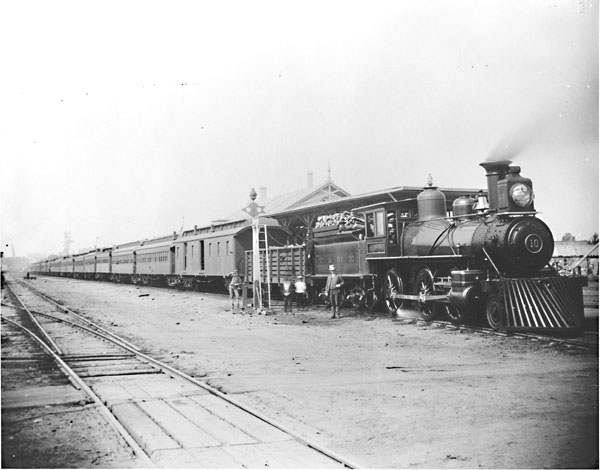
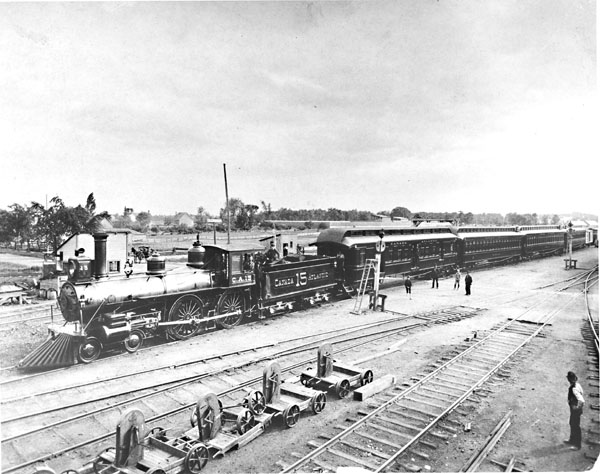
3. National Archives C-6317. Canada Atlantic locomotive No. 15 and train at Elgin Street station taken from the roof of the car shops looking south west. The first car is standing on (and blocking) Elgin Street. 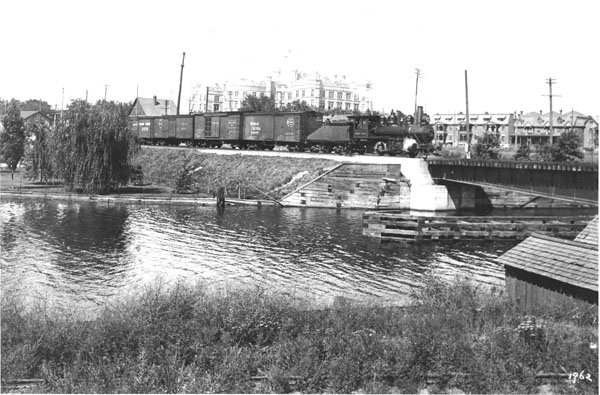
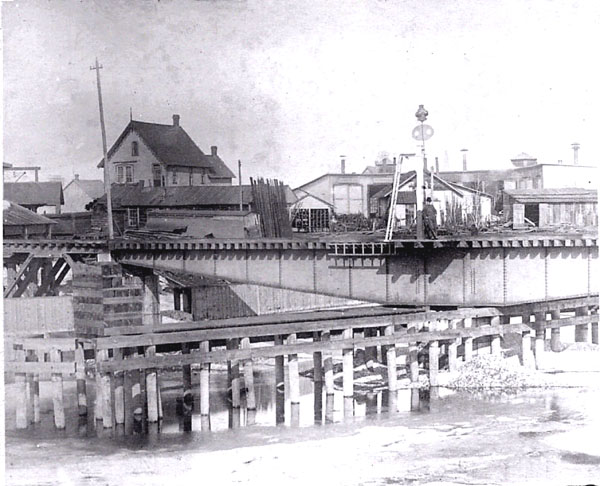
Trackwork and signals Immediately west of the swing bridge, a stub switch with an integral oval target signal led to the freight yard lead on the south side. A second stub switch led towards the passenger station on the north side. The main line and these two lead tracks led across Elgin Street. Access to the car shed and roundhouse was from a three-way stub switch at the east end of the platform. This added two more to the three tracks at the crossing. A sixth track across Elgin street from the south edge of the freight yard gave access to the enclosed Isabella Street coal trestle on the west bank of the canal. There are several photographic views of this crossing which show all these tracks and the stub switches. The three-way switches are distinguished by the signal targets which incorporate an arrow, so that right and left, as well as straight through, can be distinguished. All the signals incorporated a multi-lens lantern and a ladder for servicing it. In later years, a tall train order signal mast was installed. It had a single head which dropped to an invisible position against the mast. Similar signals were seen at a few other stations of that period. Additional stub switches were installed on the east side of the Elgin Street crossing. The northernmost one was another three-way switch giving access to one car shed track and two turntable tracks. The next one was a two-way switch to a storage track along the south wall of the car shed. Because of the complexity of the trackwork across Elgin Street, it was eventually necessary to install barrier gates, which appear in a 1900 photograph, as well as a high watchman's tower to guard the crossing, visible in the same photo. However, there was never an interlocking plant at this location, except years later for the swing bridge. The switches and signals remained manually operated. Expansion to the west
The line west of Bank Street was extended via crossings of Preston Street and Richmond Road to a station at Broad Street, opened on 1 January 1885. At first, the Montreal trains originated and terminated at this station, known as Richmond Road, although the passenger trains continued to be stored at the Elgin Street car sheds. By June 1886 service to and from Richmond Road was shown as a connection to and from Elgin street and service was discontinued in June 1888, not to be reinstated. The reason given was that CAR was extending to the Chaudiere lumber mills and then passenger trains got in the way of the construction trains. The Richmond Road station was used for excursions such as the annual Canada Atlantic employees excursions to Clark Island. On 13 May 1893, Booth's Ottawa Arnprior & Parry Sound Railway opened from Chaudiere Junction, near Rochester Street west as far as Arnprior. A second west-facing stub track was added at the station to serve this route. Streetcar Service
Although the Ottawa City Passenger Railway started operating horsecars in July 1870 there was never horsecar service to the Elgin Street station. However, the electric street railway was quickly extended along Elgin and Catherine Streets and service to the Canada Atlantic station commenced at 09:00 on 23 July 1891, car 17 being the first one to arrive. The Ottawa Electric Railway quickly completed a contract to convey the mails between the Post Office and the railway stations and a siding for this purpose at the Elgin Street station was completed on November 1st 1893, in time for the commencement of mail service on November 9th. This electrified line ran directly along the east side of the platform. Until the commencement of the streetcars the only other public transport available was the horse drawn cabs. Train time became pretty rowdy with drivers pretty much fighting for business. A favorite trick was to grab hold of a case or bag so the unlucky traveler had no option but to follow behind. The Canada Atlantic appointed a police constable, Mr. Patrick Hurley, in January 1889, to help keep order but the problem was only partially solved. In August 1894 a passenger complained that he was mobbed by cab men and his satchel was torn out of his hands. Facilities Replaced
In September 1888 a plan was published suggesting that a new terminus would be built, further north up Elgin Street, close to Shanly’s original location. However, the railway was having considerable difficulty with local residents who complained vociferously about the noise and danger from the amount of switching across Bank and Elgin Streets, which were flat crossings at either end of the station. A new location was needed and in January 1891 the Canada Atlantic informed the City Council that it was negotiating with the federal government to use the Canal Reserve to reach a new station between the Maria Street (Laurier) Bridge and the Canal Basin. Passenger trains, both east and west, started to use the Maria Street station on 23rd December 1895 and the Elgin Street station was closed at that time. The platform was ripped up on December 24th and the building was converted to a store house in January 1896. After this date, very few passenger trains called at Elgin Street, but bypassed it on the main line. In the last Canada Atlantic timetable of 1905 a westbound mixed train still made an early-morning stop there. However, the station tracks had by then been built over with freight car-building shops constructed in 1899. The Canada Atlantic also built a large shop facility in Ottawa East in 1896, in the space formed within the wye of the Canada Atlantic and the OA&PS. Initially 10 acres was filled for a 360-degree roundhouse, a locomotive erecting shop, a machine shop, boiler house, and stores. However, the car shed and the roundhouse at Elgin Street remained in use, for minor maintenance, such as painting and glazing of passenger cars. Special Events
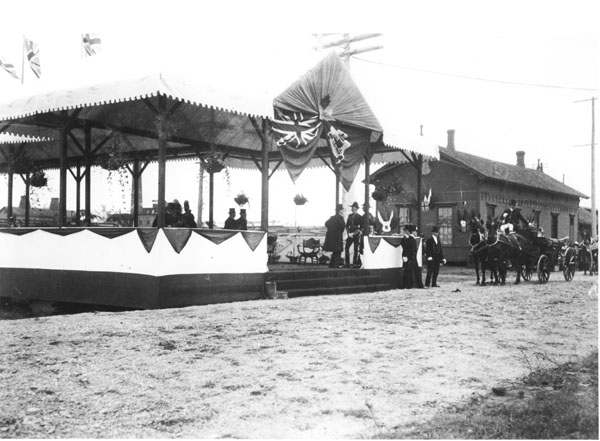
On 1 November 1901 the station welcomed the return of the troops from the South African War. They formed a parade in the station area and then proceeded up Elgin Street, led by Civic Officials to the Drill Hall on Laurier Avenue at the Canal. The Canada Atlantic erected flags and a large banner at the station and Elgin Street was similarly decorated. (National Archives photo C-7978.) Fires
A large fire in August 1899 destroyed the roundhouse on Archibald Street. Fortunately the wood structure was consumed quickly and the machinery inside was not heavily damaged. There were no major equipment losses. A second fire in March 1902 completely destroyed the car shed in a spectacular blaze that could not be brought under control, despite the quick arrival of two fire engines. Several passenger cars were destroyed inside the shed, as well as quantities of paint and supplies. Different guesses have been made as to which cars were lost, but Pullman coach number 300, which is usually listed had already been written off after the St. Polycarpe crash of August 1900, so was probably not one of them. This night time fire was captured in a dramatic sketch published in the newspaper. It showed the car shed, the crossing tower, and the coal stage. Neither of the burned buildings was replaced, as the new shops at Ottawa East provided sufficient facilities and it had also been planned to construct a new 300-foot long paint shop there. The destruction of the car shed actually permitted the rerouting of Elgin Street to a new underpass near the canal. The last fire was in 1941 at the old station building, which was now being used as car department offices and stores. The original one-storey building was very tall and an attic floor had been added with new end windows. It was not in use, however, and it was believed that it was here that overheated stove pipes started the blaze. The fire was confined to the attic, but it appears that the building was demolished soon after. Legacy
After 1905 and until 1955 the station area became part of the Grand Trunk and Canadian National Bank Street yards. The route to Arnprior and the west was abandoned in 1952 when trains were diverted via the former Canadian Northern Beachburg subdivision. However, there were still tracks in this area to reach the Chaudière until 1965. Without the land assembled by J.R. Booth to reach Elgin Street, create the station and yards there, and continue westwards towards Chaudiere and Arnprior, there would have been no cross-town corridor for the Queensway. Jacques Gréber seized on it in 1948 for his planned cross-town parkway, though CNR President Donald Gordon and his predecessors tried hard to persuade the Federal District Commission and the Federal Cabinet to leave a rail line in the same corridor. Today the site of the station is a grassy bank beside the Queensway westbound off-ramp at Metcalfe, the car shed site is along the Queensway east of Elgin, and the roundhouse has been replaced by the Tiffany Apartments, with two side wings still suggesting the curve of the original structure. 
7. National Archives C-25996. This shows the Canada Atlantic Railway crossing of Elgin Street in January 1897 looking towards the south east quadrant. In January 1892 the City of Ottawa complained to the Privy Council Railway Committee that there were six tracks crossing Elgin Street. The City wanted to ensure people could use Elgin Street to get to the Exhibition Grounds and wanted the railway to move the yard to the east of the Rideau Canal. The Committee asked the City to submit plans for an alternative scheme and to arrange the amount of compensation they were prepared to make to the Company for the removal of their tracks. The matter rested here until the construction of the Elgin Street underpass in 1902. There are lights strung over the crossing to illuminate the crossing at night. Street cars were not allowed to cross the tracks here until mid 1899 when gates were installed to provide protection but the wires shown were used by the streetcars making the turn on to Catherine Street (to the right of the picture) 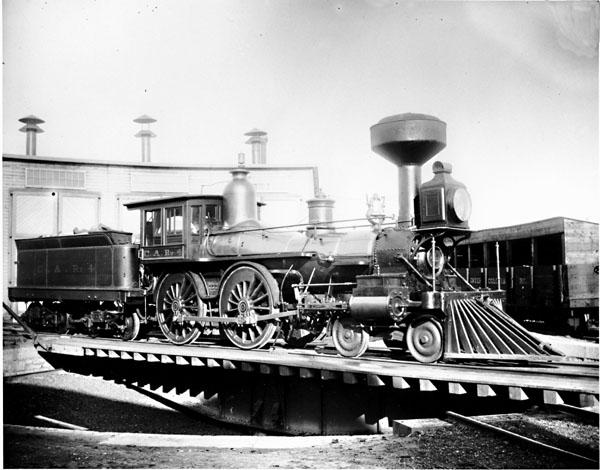
8. National Archives PA-205956. This shows Canada Atlantic locomotive 4 “Casselman” on the turntable at the Elgin Street engine house. Sources
Newspapers – The Ottawa Daily Citizen and the Ottawa Evening Journal have been extensively reviewed. In fact, every issue of the Journal from December 1885 until March 1911 and the Citizen from 1852 until 1900. The authors would be pleased to give specific references if requested. National Archives – files and plans as noted Canadian Railway and Marine World. Bytown Railway Society, Branchline, February 2004. The Canada Atlantic Railway Elgin
Street (Ottawa) Station – A Postscript
In our article on the Elgin Street station in the February 2004 Branchline we mentioned that service between Ottawa and Arnprior over the Ottawa, Arnprior and Parry Sound Railway commenced on 13 May 1893 and mentioned that a second west facing stub track was added at the station to serve this route. Subsequent research in the pages of the Ottawa Free Press has uncovered additional details of the arrangements that were made to accommodate the additional traffic that arose as a result of the extension to Arnprior and further west. Although a mixed train service commenced on 13th May 1893 the regular service did not commence until Monday 18th September 1893. The changes and improvements made are best described from the pages of the Ottawa Free Press. 26th August 1893 “Radical changes are being made at the C.A.R. Elgin street depot. The big baggage room building will be moved eastward and a siding which runs past the freight shed will be carried down on the northern side of the station to the station house. As the yard is now situated there is only one track off which the passenger trains start. Since the Parry Sound road has started running its morning train the one track has not been sufficient to accommodate the trains. This new siding on the north side of the station will be solely for the Parry Sound trains. A siding will also be placed on the north side of the long freight shed and off this all freight can be unloaded. A gang of men are engaged this morning tearing up the switch in front of the baggage room. The new track will not be of any great length as it will only be a continuation of the siding further up the yards. Two long platforms will extend on each side of this Parry Sound landing for quite a distance. Mr. Donaldson says the change is a matter of trial and if it works will be continued and if not then the track can easily be torn up again. The railway company owns considerable land behind their station so that there is plenty of room for new sidings.” 14th September 1893 “The new sidings and platforms at the C.A.R. depot are about completed. The Parry Sound train will start from the new track at the beginning of next week.” 18th September 1893 “Improvements around the Canada Atlantic railway Elgin street depot are going on rapidly. The platforms have been repaired and extended towards Bank street. The new sidings for the Parry Sound railway are complete.” 29th September 1893 Bytown Railway Society, Branchline, May 2004. |
![]()